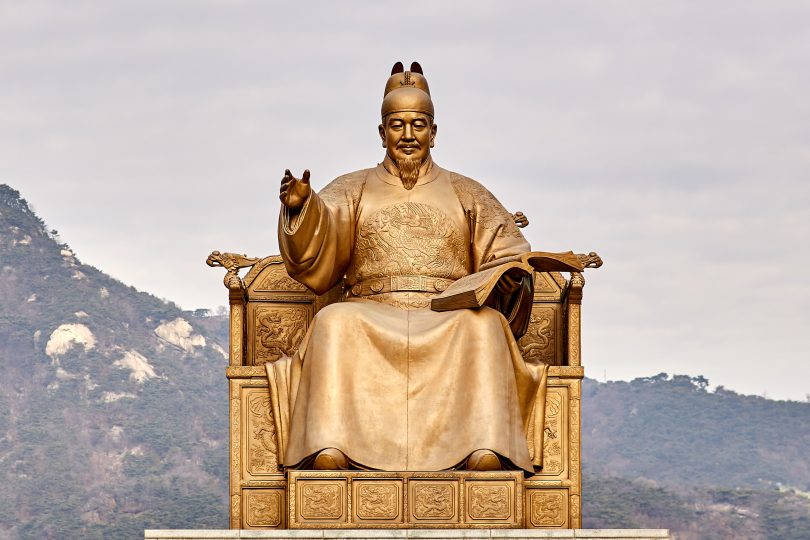King Sejong Shows the Way for Business Meetings Today
By Yang Sung-jin (insight@heraldcorp.com)
2012-03-06, Korea Herald
http://www.koreaherald.com/common/newsprint.php?ud=20120306001255 (accessed November 2, 2018)
Historical records show the famous king turned court meetings into exchanges of productive ideas
Have you ever been in a business meeting wondering why you are there? In typical Korean corporate culture where junior staff members are supposed to remain meekly silent while the boss demands fresh ideas, meetings are, if anything, costly time-wasters.
Business meetings have three negative associations: boring, tiring, unnecessary. And the most serious issue is that most meetings get wrapped up without producing any tangible results.
Historical records show the famous king turned court meetings into exchanges of productive ideas
Have you ever been in a business meeting wondering why you are there? In typical Korean corporate culture where junior staff members are supposed to remain meekly silent while the boss demands fresh ideas, meetings are, if anything, costly time-wasters.
Business meetings have three negative associations: boring, tiring, unnecessary. And the most serious issue is that most meetings get wrapped up without producing any tangible results.
Major Korean conglomerates, which are quick to adopt foreign management tips and tricks, are enacting reforms to turn otherwise boring and unproductive meetings into something useful.
Some companies set a time limit for meetings, a max of 29 minutes. To be more informal (because in a formal setting employees are often reluctant to say anything for fear of upsetting their boss), meetings are now held in a company cafe or in a place labeled the “discussion room” rather than “meeting room.”
But experts point out that Korean businesspeople tend to carry out meetings that produce no results or conclusion, last longer than necessary, and focus on the unilateral delivery of a message or orders by the boss rather than a discussion of ideas on equal footing. Worse, post-meeting feedback or monitoring of results is a rarity.
Enter King Sejong of the Joseon Dynasty, who was born in 1397 and emerged as the country s most respected ruler. The famous monarch, who led the invention of the Korean alphabet, was an expert on business meetings. Unlike other kings who avoided court meetings with officials, King Sejong held 1,898 court meetings called “gyeong-yeon”경연 經(classics) 筵 (bamboo mat) during his 31-year reign.
“Gyeong-yeon was a project that educated the crown princes or the kings in a format that is similar to today s academic seminars,” said Kim Kee-seop, chief of the publishing team at the Korean Leadership Academy.
Kim, also a researcher at the Sejong Leadership Institute affiliated with the Academy of Korean Studies, said the Joseon court’s meeting format offers valuable lessons to modern businesspeople.
Gyeong-yeon was made up of two sessions. In the first part, court officials and the king read a Chinese classical text together and offered their own interpretations. In the second and final part, they applied what they had just read to a current agenda or issue and tried to produce a solution that could be implemented.
Reading a text together and sharing a common experience is a key suggestion for managers to consider to make meetings more productive. Although it’s not that realistic for busy participants to read a classical text in advance, sharing a view or experience on certain issues could accelerate discussion.
Atmosphere is also important. Just imagine what would happen when an official proposed a dissenting view in front of the all-powerful king in the 14th century. Unlike other kings who failed to manage their anger, King Sejong kept cool even during provocative statements from his officials.
For instance, an official raised an overblown objection to one of Sejong’s ideas in a meeting held on March 13, 1440, over a revised act that extended the tenure of provincial administrators. According to the Joseon Annals, other officials urged the king to punish the dissenter, but King Sejong refused.
“If I punish him, who would dare to say what he wanted say in front of me?” the king replied.
King Sejong lost his temper 21 times during his entire reign, averaging 0.06 times per month, which is far lower than other kings such as King Taejong (0.46 per month) and King Yeongjo (0.24 per month).
A take-home lesson for today s team leaders and CEOs: Make sure employees in a meeting talk freely without worrying about negative consequences from their ideas and suggestions, and never lose your temper.
King Sejong was good at breaking the ice before holding regular meetings, often dancing with court officials or calling them by their nicknames.
While the king made sure participants remained relaxed and willing to talk freely, he also focused on turning a good idea into a policy through post-meeting monitoring and public polls. King Sejong filtered out ideas by giving three ratings to suggestions and made a final decision based on integrated perspectives and pragmatism.
“Some might argue that King Sejong s meeting style is too slow for today’s speed-oriented corporate culture, but as King Sejong demonstrated, even in a brief meeting, preparations and meeting skills are important,” said Kim Kee-seop.
“Instead of telling people to come up with ideas right away, reading together an interesting text that is related to the meeting agenda would change the results dramatically.”
10 King Sejong-inspired principles of business meetings
- Adopt a three-stage rating system for new ideas
King Sejong filtered ideas by giving top, middle and bottom grades to brainstormed suggestions during court meetings. He made a final decision after considering various factors in an integrated fashion. He also adopted a pragmatic approach by comparing input and results.
- Set up a proper atmosphere for meetings
King Sejong broke the ice by using his officials nicknames or dancing together ahead of court meetings so that they could be relaxed and willing to express their views freely.
- Don t lose your temper
King Sejong lost his temper quite rarely, less than once a month. Once you get angry or show any sign of negative emotions such as contempt toward others views, the chance of getting a creative result is close to zero.
- Avoid perfunctory meetings
When participants feel a meeting is just a perfunctory procedure, its productivity goes down instantly. Getting people who directly handle the issue in question to join the meeting can be a solution as they get the otherwise boring discussion moving forward with input of fresh ideas.
- Consider the people who might be affected by the decision reached in the meeting
In setting up a new policy through court meetings, King Sejong placed top priority on considering the impact on the populace, especially those in the minority or lower class.
- Read a text together and then explore the agenda
Reading classical texts offers insight into issues. King Sejong set an example by reading texts with his officials and working on pressing issues based on the insights they gained together.
- Form a task force to move ideas beyond the meeting room
King Sejong formed an agency called “Sangjeongso” 상정소 (詳 ‘details’ 定 ‘decide’ 所 ‘office’) to map out action plans that stemmed from court meetings. The action plans, then, were explored by other key administrative organizations before they were adopted as formal polices.
- Listen to dissenting views
King Sejong listened to all the dissenting voices before adopting a new idea. His strategy was aimed at reducing inherently defective or flawed policies.
- Recognize others view first
King Sejong stuck to a gentle discussion style. Instead of offering negative feedback to an idea, the king tended to recognize others ideas by frequently saying “You are right” and “Your opinion is admirable.”
- Put a monitoring system in place
King Sejong was eager to collect views from the public in implementing a major policy. He conducted, for instance, a massive survey of 170,000 people before revising public laws. In fighting against the northern invaders, the king deployed an intricate monitoring system based on a mix of court meetings and field reports.
Source: Kim Kee-seop, chief of publishing team at the Korean Leadership Academy



